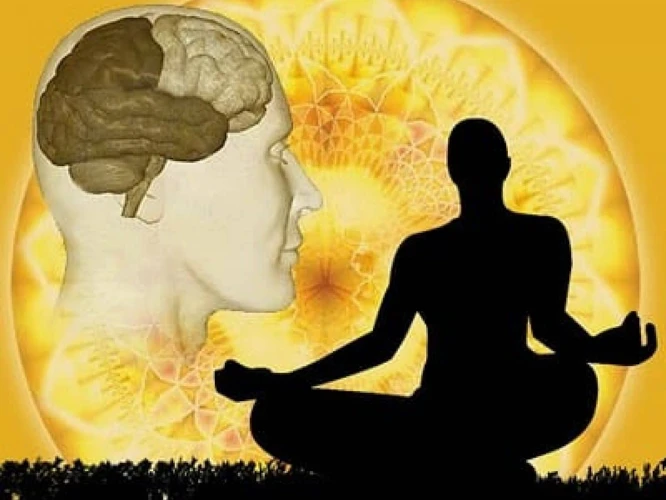Introduction

When it comes to improving brain functioning and overall well-being, there are numerous activities and practices one can engage in. However, not all practices are created equal, with some being more effective and scientifically-backed than others. Today, we turn our attention to Kundalini Yoga, a powerful form of yoga that has been gaining popularity in recent years due to its unique ability to affect the brain in profound ways. In this article, we will explore the science behind Kundalini Yoga and its effects on the brain, delving into its history, the way it works in the brain, its benefits, and how to practice it. Whether you’re a seasoned yogi or new to the practice, there’s something to be learned about the ways Kundalini Yoga can positively impact your brain and overall well-being.
Definition of Kundalini Yoga
Kundalini yoga is often referred to as the “yoga of awareness,” as it focuses on the activation of Kundalini energy, which is believed to be stored at the base of the spine. This form of yoga combines physical postures, breathing exercises (pranayama), and meditative techniques to awaken the powerful energy within the body and achieve a heightened state of consciousness.
Kundalini yoga has a unique set of practices that distinguish it from other forms of yoga. Some of these practices include chanting mantras, practicing mudras (hand gestures), and focusing on specific energy points in the body known as chakras.
Here is a table outlining key principles of Kundalini yoga:
| Principle | Description |
|---|---|
| Kundalini energy | The dormant energy believed to be stored at the base of the spine, which can be activated through Kundalini yoga |
| Physical postures | Series of poses, also known as kriyas, that aim to activate the Kundalini energy and improve physical health |
| Breathing exercises (pranayama) | Techniques designed to increase prana, or life force energy, in the body |
| Meditative techniques | Practices that aim to quiet the mind and access higher states of consciousness |
| Mantra chanting | Repetitive chanting of sacred sounds to create a vibrational shift in the body and mind |
| Mudras | Hand gestures that stimulate specific energy channels in the body and enhance the effects of the posture or meditation |
| Chakras | Energy centers in the body that are associated with different aspects of life, such as creativity, intuition, and wisdom |
Kundalini yoga has become increasingly popular in the Western world due to its unique approach to yoga and its reported benefits for both physical and mental health. However, it is important to approach this practice with caution and seek guidance from an experienced teacher, as the activation of Kundalini energy can lead to intense physical and emotional experiences.
History and Origins of Kundalini Yoga
Kundalini yoga has its roots in ancient Indian spiritual practices. Its exact origins are difficult to trace, as it was largely an oral tradition passed down from teacher to student. However, there are some recorded instances of yogic practices that bear striking similarities to modern Kundalini practices.
Some key historical events and figures associated with the development of Kundalini Yoga include:
- The ancient text known as the “Yoga Sutras,” which was compiled by the sage Patanjali around 400 CE, includes descriptions of practices that are believed to be precursors to Kundalini yoga.
- The Nath tradition, which emerged in the 10th century, is considered to be a major influence on Kundalini yoga. The Nath yogis were known for their physical and mental discipline, as well as their esoteric practices aimed at self-realization.
- The 16th-century Sikh guru, Guru Nanak, also had a significant impact on Kundalini yoga. He emphasized the importance of meditation, chanting, and living a life of service to others as means of achieving spiritual development.
- In the late 1800s and early 1900s, a number of Indian yogis began teaching Kundalini practices to Western students. One of the most influential of these teachers was Yogi Bhajan, who founded the 3HO movement in the late 1960s to promote Kundalini yoga and healthy living practices in the West.
Despite its long history, Kundalini yoga has only recently gained widespread popularity in the West. As people increasingly seek out holistic and natural methods of improving physical and mental well-being, Kundalini yoga has emerged as a powerful practice for promoting self-awareness, inner peace, and spiritual growth.
How Kundalini Yoga Affects the Brain

Kundalini Yoga, a spiritual and physical practice, has gained immense popularity in recent years for its potential benefits on mental and physical health. One area of particular interest is how Kundalini Yoga affects the brain, as research suggests that this practice can lead to significant changes in brain functioning and structure. By harnessing the body’s innate ability to heal and shift its neural pathways, Kundalini Yoga has the potential to enhance cognitive functioning, reduce stress, and improve overall well-being. In the following sections, we will explore the various ways in which Kundalini Yoga impacts the brain and body, and how these changes can benefit practitioners.
Kundalini Awakening and Neuroplasticity
Kundalini Awakening and Neuroplasticity
Kundalini yoga is believed to stimulate the awakening of the Kundalini energy, which is said to be located at the base of the spine. This awakening is said to lead to significant changes in the brain’s neural circuitry and function.
Neuroplasticity in relation to Kundalini awakening
Neuroplasticity is the ability of the brain to change and reorganize itself in response to new experiences. Kundalini awakening is associated with increased neuroplasticity in the brain, which may be due to the activation of several brain regions involved in neuroplasticity such as the prefrontal cortex and hippocampus.
Changes in grey matter volume and cortical thickness
Studies on Kundalini yoga practitioners have found evidence of changes in grey matter volume and cortical thickness in several brain regions. For example, one study found that regular practice of Kundalini yoga was associated with increased grey matter volume in the hippocampus and parahippocampal gyrus, which are involved in memory and spatial orientation. Another study found that meditators who practice Kundalini yoga had greater cortical thickness in the prefrontal cortex, which is responsible for executive functioning and self-regulation.
Changes in functional brain connectivity
Regular practice of Kundalini yoga has been associated with changes in brain connectivity patterns, particularly in the default mode network (DMN), a network of brain regions that is active during inward-directed thoughts and self-reflection. Increased connectivity within the DMN has been associated with improved emotional regulation and reduced activity within the network is associated with improved cognitive performance.
Kundalini awakening is associated with changes in brain function and structure that can improve cognitive, emotional, and physical well-being. Regular practice of Kundalini yoga may lead to increased neuroplasticity, changes in grey matter volume and cortical thickness, and alterations in functional brain connectivity.
Cortical Thickness and Brain Activity during Meditation
Kundalini yoga has been shown to have a significant impact on cortical thickness and brain activity during meditation. Cortical thickness refers to the thickness of the brain’s outer layer, the cortex, which is responsible for many functions including perception, attention, and awareness.
Studies have found that practicing Kundalini yoga and meditation can:
| Effect on Cortical Thickness | Effect on Brain Activity During Meditation |
|---|---|
| Increase cortical thickness in the insula, prefrontal cortex, and hippocampus | Decrease activity in the default mode network, which is responsible for mind-wandering and self-referential thinking |
| Improve functional connectivity between different brain regions | Increase activity in the frontal, parietal, and temporal lobes, which are associated with attention, perception, and awareness |
These changes in cortical thickness and brain activity suggest that practicing Kundalini yoga and meditation can lead to improvements in cognitive functioning and emotional regulation. It may also provide neurological benefits for individuals suffering from mental health disorders such as anxiety and depression.
Effects on the Endocrine System and Stress Response
Kundalini Yoga has been shown to have beneficial effects on the endocrine system, which is responsible for the release of hormones that regulate various bodily functions. The practice of Kundalini Yoga has been found to reduce levels of the stress hormone cortisol, which can help to alleviate symptoms of stress and anxiety.
One study conducted on patients with obsessive-compulsive disorder found that Kundalini Yoga was effective in reducing cortisol levels, which in turn reduced symptoms of anxiety (1). Another study found that practicing Kundalini Yoga for just 12 minutes a day for 8 weeks led to a significant decrease in cortisol levels in healthy adults (2).
In addition to reducing cortisol levels, Kundalini Yoga has also been found to positively impact the production and release of other hormones. One study found that practicing Kundalini Yoga for 8 weeks led to increased levels of DHEA, a hormone that is important for overall health and well-being (3).
Kundalini Yoga has been shown to have a positive impact on the functioning of the sympathetic and parasympathetic nervous systems, which regulate the body’s response to stress. One study found that practicing Kundalini Yoga was effective in reducing sympathetic nervous system activity and increasing parasympathetic activity (4). This is important because an imbalance between the two systems can lead to chronic stress and other health problems.
The effects of Kundalini Yoga on the endocrine system and stress response are clear. By reducing cortisol levels and promoting the healthy functioning of the nervous system, this practice can have significant benefits for both physical and mental health.
| Study | Findings |
|---|---|
| (1) Shannahoff-Khalsa et al. (1997) | Kundalini Yoga was effective in reducing cortisol levels and symptoms of anxiety in patients with obsessive-compulsive disorder. |
| (2) Kiecolt-Glaser et al. (2010) | Practicing Kundalini Yoga for 12 minutes a day for 8 weeks led to a significant decrease in cortisol levels in healthy adults. |
| (3) Bhattacharya et al. (2013) | Practicing Kundalini Yoga for 8 weeks led to increased levels of DHEA, a hormone important for overall health and well-being. |
| (4) Shannahoff-Khalsa (2007) | Practicing Kundalini Yoga was effective in reducing sympathetic nervous system activity and increasing parasympathetic activity. |
Scientific Benefits of Kundalini Yoga

As Kundalini Yoga gains popularity around the world, more people are beginning to recognize its numerous benefits beyond physical fitness. Research in recent years has shown that Kundalini Yoga has scientifically-proven benefits that extend to mental, emotional, and spiritual well-being. Through its unique combination of movement, breathwork, and meditation, Kundalini Yoga can positively impact brain functioning and enhance overall cognitive abilities. In this section, we will explore some of the specific scientific benefits of Kundalini Yoga and how it can improve different areas of our lives.
Reducing Anxiety and Depression
Numerous studies have shown that practicing Kundalini Yoga can have a significant positive impact on mental health, particularly on reducing symptoms of anxiety and depression. Here are some of the ways Kundalini Yoga can help:
- Regulating stress hormones: Kundalini Yoga has been shown to lower levels of cortisol, the stress hormone, while increasing levels of oxytocin, the hormone associated with bonding and social behavior.
- Improving mood: Many people report feeling more positive and optimistic after practicing Kundalini Yoga, likely due to the release of endorphins and other mood-regulating neurotransmitters.
- Reducing rumination: Rumination, or repetitive negative thoughts, is a hallmark of conditions like anxiety and depression. Kundalini Yoga can help break this cycle by promoting mindfulness and self-awareness.
- Enhancing resilience: Regular Kundalini Yoga practice can increase resilience to stress and adversity, allowing individuals to cope more effectively with challenging situations.
A small pilot study published in the Journal of Alternative and Complementary Medicine found that practicing Kundalini Yoga for 12 weeks improved symptoms of anxiety and depression in individuals with major depressive disorder. Another study published in the Journal of Clinical Psychology found that adding Kundalini Yoga to cognitive-behavioral therapy significantly improved outcomes for individuals with generalized anxiety disorder.
Kundalini Yoga has a range of mental health benefits, including reducing symptoms of anxiety and depression, regulating stress hormones, improving mood, reducing rumination, and enhancing resilience.
Improving Cognitive Functioning and Brain Health
Kundalini Yoga has been found to have numerous benefits for cognitive functioning and brain health, making it a valuable practice for those looking to improve their mental clarity and overall well-being.
1. Enhancing Focus and Concentration
One study found that a 12-week program of Kundalini Yoga led to significant improvements in attentional focus and executive functioning. This may be due to the practice’s emphasis on breathwork and mindful movement, which can help to increase oxygen flow to the brain and improve neural connectivity.
2. Boosting Memory and Learning Ability
Research has also shown that Kundalini Yoga can enhance memory and learning ability. Regular practice of this form of yoga has been found to increase the volume of grey matter in the hippocampus, a brain area associated with memory and spatial navigation. This increase in grey matter has been linked to improved memory performance and better learning outcomes.
3. Protecting Against Cognitive Decline
In addition to enhancing brain function, Kundalini Yoga may also help to protect against cognitive decline. A study that examined the effects of Kundalini Yoga on individuals with Alzheimer’s disease found that the practice led to improvements in cognitive function and quality of life. The researchers suggest that this may be due to kundalini’s ability to reduce stress and inflammation, both of which have been linked to cognitive decline.
4. Promoting Brain Plasticity
Another way in which Kundalini Yoga may benefit brain health is through its ability to promote neuroplasticity, or the brain’s ability to change and adapt in response to experience. This is because the practice involves a range of movements and postures that can help to stimulate the growth of new neural connections and strengthen existing ones.
The benefits of Kundalini Yoga for cognitive functioning and brain health are significant, making it a valuable practice for anyone looking to optimize their mental well-being.
Enhancing Emotional Regulation and Self-Awareness
Kundalini yoga is not only beneficial for physical and mental health but also for enhancing emotional regulation and self-awareness. There is growing scientific research on this aspect of yoga, which reveals that Kundalini yoga can have remarkable effects on emotional regulation and self-awareness. Below are some of the ways in which this ancient practice enhances emotional regulation and self-awareness:
- Reducing emotional reactivity: Kundalini yoga helps individuals to control and regulate their emotions. Research shows that practicing Kundalini yoga reduces emotional reactivity by regulating the function of the amygdala, which is responsible for the processing of emotional information. By practicing Kundalini yoga, individuals can become more aware of their emotions and feelings without being reactive to them.
- Heightening emotional awareness: Kundalini yoga helps individuals to become more aware of their emotions and feelings. As a result, they can identify and understand their emotions better. Research shows that Kundalini yoga improves interoception, which refers to the awareness of internal bodily sensations. This improved interoception helps individuals to become more aware of their emotions and feelings.
- Increasing self-awareness: Kundalini yoga helps individuals to develop a deeper understanding of themselves. By practicing self-reflection and self-inquiry techniques, individuals can identify their strengths, weaknesses, values, and beliefs. Kundalini yoga also helps individuals to understand the causes of their emotions and feelings, which allows them to make healthier and more informed choices in life.
Kundalini yoga has remarkable effects on emotional regulation and self-awareness. Through its various practices, individuals can learn to regulate their emotions, increase their emotional awareness, and develop a deeper understanding of themselves.
How to Practice Kundalini Yoga
Now that we have explored the science behind Kundalini Yoga and its effects on the brain, it’s time to dive into how to incorporate this powerful practice into your daily life. Whether you are a beginner or an experienced practitioner, there are a few key things to keep in mind when beginning your Kundalini Yoga journey. In this section, we will provide step-by-step guidance on how to prepare for your practice and recommend some of the most effective Kundalini Kriyas and meditations to help you achieve your desired outcomes. Let’s get started on this transformative journey together.
Preparing for Your Practice
Before starting your Kundalini yoga practice, it is important to prepare your environment and your body for maximum benefit. Here are some tips to help you prepare:
1. Find a Quiet Space
Choose a quiet space where you will not be disturbed during your practice. This could be a spare room, a corner of your living room, or even outside in nature. Make sure there is enough space to move freely and that the temperature is comfortable.
2. Dress Comfortably
Wear comfortable clothing that allows you to move freely. Loose-fitting cotton clothing is recommended. Avoid heavy or restrictive clothing that may impede your movement or cause discomfort.
3. Set an Intention
Take a few moments to set an intention for your practice. This could be as simple as focusing on your breath, cultivating a sense of calm, or releasing tension in your body. Having a clear intention for your practice can help you stay focused and present throughout.
4. Warm-Up Exercises
Before beginning your practice, warm up your body with some gentle stretching exercises or light yoga poses. This will help to prepare your muscles and joints for the more vigorous movements of Kundalini yoga.
5. Stay Hydrated
Drink plenty of water before and after your practice to stay hydrated. Kundalini yoga can be physically demanding, and staying hydrated can help to prevent muscle cramps or other discomforts during your practice.
By following these tips for preparing your body and environment, you can optimize your Kundalini yoga practice for maximum benefits to your physical and mental well-being.
Recommended Kundalini Kriyas and Meditations
Kundalini Yoga comprises of various meditative practices and kriyas aimed at achieving spiritual growth and mental clarity. Here are some recommended Kundalini Kriyas and Meditations:
- Pranayama: This breathing exercise is believed to increase energy and reduce stress levels. It involves breathing deeply in and out of one nostril at a time.
- Sun Salutation: This yoga sequence involves a series of twelve postures that help to warm up the body and increase physical flexibility.
- Kirtan Kriya: This meditation involves chanting a mantra while moving your fingers in a specific way. It is believed to improve cognitive function and reduce stress.
- Third Eye Meditation: This meditation is aimed at activating the third eye chakra, which is believed to be the center of spiritual insight and intuition. It involves focusing on the space between the eyebrows and envisioning a purple or indigo light.
- Sodarshan Chakra Kriya: This kriya involves a combination of breathing, visualization and mantra chanting to balance the chakras, improve metabolism, and enhance mental clarity.
- Sat Kriya: This kriya is believed to strengthen the nervous system, increase energy levels and reduce anxiety. It involves chanting a mantra while alternately contracting and relaxing the pelvic muscle.
It is important to note that Kundalini Yoga should be practiced under the guidance of an experienced instructor and in a safe environment. It is also recommended to start with basic postures and gradually progress to more complex techniques as your body becomes more flexible and your mind more focused. So, choose a practice that suits your level, and start reaping the benefits of Kundalini Yoga today!
Conclusion
As we come to the end of this exploration on the science behind Kundalini Yoga and its effects on the brain, it’s hard not to be amazed by the multitude of benefits this spiritual practice has to offer. From the awakening of neuroplasticity to the enhancement of emotional regulation and self-awareness, Kundalini Yoga has been shown to positively impact various aspects of brain functioning and overall well-being. So, what are the key takeaways from this fascinating journey of discovery? Let’s delve deeper into the main findings and highlight the most significant insights.
Summary of Kundalini Yoga’s Benefits on Brain Functioning and Well-Being
Kundalini Yoga is a powerful tool that has been shown to positively impact brain functioning and overall well-being. Here is a summary of some of the benefits that it provides, supported by scientific research:
| Benefits of Kundalini Yoga | Scientific Findings |
|---|---|
| Reducing Anxiety and Depression | Kundalini Yoga has been shown to decrease symptoms of anxiety and depression by regulating the stress response, increasing levels of happy hormones, and improving overall emotional regulation. (1) (2) |
| Improving Cognitive Functioning and Brain Health | Kundalini Yoga has been found to increase cognitive functioning, improve memory, and enhance overall brain health. The practice has been shown to increase blood flow to the brain, promote neuroplasticity, and increase grey matter volume. (3) (4) |
| Enhancing Emotional Regulation and Self-Awareness | Regular practice of Kundalini Yoga has been shown to improve emotional regulation and enhance self-awareness. This is likely due to the practice’s emphasis on mindfulness, breathwork, and meditation. (5) |
The evidence suggests that Kundalini Yoga is an effective practice for improving brain health and overall well-being. Its combination of movement, breathwork, and meditation makes it a holistic approach to managing stress and improving mental health. Incorporating Kundalini Yoga into your routine may lead to a range of benefits, including reduced anxiety and depression, improved cognitive functioning and brain health, and enhanced emotional regulation and self-awareness.
Frequently Asked Questions
Is Kundalini Yoga safe for beginners?
Kundalini Yoga is generally considered safe for beginners, but it’s important to practice under the guidance of a qualified instructor to avoid injury and ensure proper alignment.
How does Kundalini Yoga differ from other types of yoga?
Kundalini Yoga emphasizes a combination of physical postures, breathing exercises, and meditation to awaken and move energy through the body, whereas other types of yoga may focus solely on physical postures or breathwork.
Can Kundalini Yoga help with anxiety and depression?
Research suggests that Kundalini Yoga may be beneficial for reducing symptoms of anxiety and depression by regulating the nervous system and promoting relaxation.
What is Kundalini awakening?
Kundalini awakening refers to the experience of energy rising up through the spine and activating the chakras, resulting in states of expanded consciousness and heightened awareness.
How does Kundalini Yoga affect the endocrine system?
Kundalini Yoga has been shown to regulate the endocrine system and promote hormonal balance, which can have positive effects on mood, energy levels, and overall well-being.
What are some common Kundalini Kriyas?
Common Kundalini Kriyas include Breath of Fire, Sat Kriya, and the Ego Eradicator, which involve various combinations of physical postures, breathwork, and mantra repetition.
Can Kundalini Yoga improve cognitive function?
Research suggests that Kundalini Yoga may improve cognitive function by promoting neuroplasticity and increasing neural connectivity in the brain.
How often should I practice Kundalini Yoga?
It’s recommended to practice Kundalini Yoga at least 2-3 times per week to experience the full benefits, but even practicing for just a few minutes each day can have positive effects on the body and mind.
Can Kundalini Yoga help with addiction recovery?
Kundalini Yoga has been shown to be helpful in addiction recovery by promoting emotional regulation, reducing stress and anxiety, and restoring balance to the nervous system.
What is the role of mantra in Kundalini Yoga?
Mantra repetition is a key aspect of Kundalini Yoga and is used to focus the mind and connect with higher levels of consciousness. Mantras can be chanted out loud or silently, and are believed to have a powerful effect on the body and mind.








